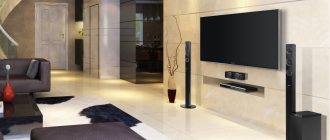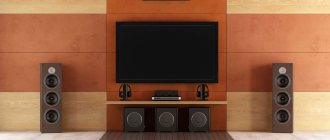Home cinema included.
A classic Hi-Fi home theater is a 5.1 system that uses a pair of front speakers on either side of the screen, one center channel, a pair of rear speakers and a subwoofer. 7.1 or 7.2 systems are also often installed, where side speakers and a second subwoofer are added accordingly. Next come home theater systems 9.1, 11.2, 13.2 and many more options for the placement of acoustics, including even ceiling ones. When building a home theater, you can use any type of speaker systems - floor-standing, bookshelf, suspended, built-in, active and wireless.
The second element of a home theater is a receiver, or as it is now commonly called an AV amplifier, which includes a switch for all digital and analog signal sources, a multi-channel amplifier, surround sound decoders - Dolby Digital, DTS, Dolby Atmos, Auro 3D, DTS X and many others. Equipped with network functions for listening to music from your home network, that is, a computer, server and other network storage, as well as for listening to music from the Internet. It can connect via cable, via Wi-Fi and additionally connect via Bluetooth to mobile devices. It has a large number of settings in manual and automatic mode. They are divided by the number of channels from 5.1 to 16, power and some additional functions. Serious systems use separate components - a processor and an amplifier or several power amplifiers, depending on the number of channels/speaker systems, up to 64!
The next component is the source of audio video content; there may be several of them. Blu-Ray player, media player, game console, satellite receiver, TV set-top box and others.
And of course, you can’t do without a video display device; it can be a TV, preferably a large one, or a projector with a special screen (a white wall or a sheet will not work if you need a high-quality picture).
A simple example of a Dolby Atmos home theater with a projector and screen. You will need a set of 11.2 acoustics, which will have two front speakers, a center channel, two upper front speakers, two rear, two side, two ceiling and two subwoofers, a receiver with the appropriate number of amplification channels, an audio video player and a projector with a screen. The cost of such a home theater can vary from several hundred thousand to several million rubles. But, a cinema can be created for almost any budget, even starting from several tens of thousands - it will, of course, be a simple 5.1 version with small speakers, and if you assemble a home theater using High-End components, then the cost in this case can be completely indecent. And regardless of the price of a home theater set, our salon always has an individual approach to any client, consultation and selection of all equipment, on-site installation and training on system management.
Speakers
We will discuss several different types of speaker systems.
Integrated
TVs will have built-in speakers, but there won't be much power behind them. They are inferior to all other types, but better than nothing at all. Not all projectors come with speakers. Today's TVs are so thin that the speakers inside them need to be smaller too. It is physically impossible for thin TVs to reproduce very deep sounds like what a subwoofer can produce.
Soundbar
A soundbar is literally a long panel of speakers that sits or mounts directly above or below your TV. It houses several small speakers that can create a sense of surround sound in a room, even if the sound is only coming from the speakers in front of you.
It can be much less expensive than a full speaker system and still provide excellent sound quality for the entire room. They can usually connect subwoofers or other surround speakers wirelessly, providing a pleasant fullness to the room. Almost all soundbars contain a built-in amplifier that supplies power to the speakers, meaning that the soundbar will only need power and an audio source to operate.
This is generally a much simpler setup than a receiver that has a lot of speaker cables connected to it. In a room where running cables to all the speakers can be difficult, using a soundbar with wireless surround speakers is a great option; however, it will likely end up being more expensive than a traditional surround sound system.
Surround sound system
I'm sure many of you have heard of 5.1 or 7.1 surround sound. The first number is the number of channels available for the speakers, and the second number is the number of available subwoofer outputs. So, 5.1 = 5 speakers and 1 subwoofer, 7.2 = 7 speakers and 2 subwoofers, etc.
A typical 5.1 surround sound system contains center, front left, front right, left surround, right surround, and a subwoofer. Depending on the shape of the room and seating arrangement, there are many different ways to place or configure speakers. Typically, you'll want to face the speakers towards the main seating area.
There are also different types of speakers that can be used in this type of installation, such as floorstanding, in-wall, in-wall, in-ceiling and bookshelf speakers. A full surround sound system (properly set up) will sound great! This is a whole new level of movie watching in your own home! The downsides to a full surround sound system are the cost and setup, but in my opinion they are worth it.
How to choose a home theater for your home.
On the one hand, the choice can be very simple; it is to buy a ready-made solution, the so-called one-box home theater. Or take this issue seriously. Determine the room in which the home theater or home cinema will be built; in this case, this is a specially designated room in which it will also be necessary to carry out acoustic treatment. Select acoustic systems appropriate to the size of the room, quantity, power, decide on the type of placement - floor, shelf, built-in, etc. The design of the acoustics will also be important. Select the appropriate receiver or processor with a power amplifier and the necessary sources of audio video content. And decide on what you will watch movies on, TV or a screen with a projector. If you are building a home cinema, definitely a projector! To simplify the choice of equipment for a recreation center, it will be easier for you to contact us at the M-stereo salon, we will help.
Home theater elements
To create a home cinema room, it is not necessary to have a large area. Modern audio and video equipment, thanks to technological progress, is compact in size and will look harmonious even in a small apartment. To create the necessary cinema backdrop, you can purchase a complete set or individual elements. If you have a large-screen TV, it is enough to purchase an AV receiver and speakers. With the right approach, you can make a real cinema at home without spending large sums.
If the goal is to create a full-screen viewing and the area of the room allows, the cinema can be assembled from the following components:
- projector screen;
- projector;
- personal computer or laptop;
- audio system;
- window filters.
For less global implementations, you can purchase a home theater with a good subwoofer and speakers and connect it to a stationary TV screen or computer monitor. Acoustics can have different configurations. For premises up to 30 sq.m. surround sound will be provided by 5.1 acoustics. This is an audio system installed with a subwoofer directly next to the screen and four speakers placed on the sides.
Which home theater projector to choose?
There are a huge number of projector options on the market, from tiny pico projectors to huge cinema projectors. And which projector to choose? It is necessary to take into account the size of the room where the cinema will actually be, the desired or possible size of the screen, how dark the room can be, the darker the better. Possible installation location, distance to the screen. And of course the image quality you want to achieve. By adding up all these parameters, you can select the right projector, but in this case it is better to contact specialists, you will significantly save your time.
A few answers to frequently asked questions
How is a home theater different from a TV?
A TV is just a video display device with very mediocre sound due to its physical characteristics.
How is a home theater different from a music center?
The music center includes only two speakers, which will not create the effect of presence when watching movies.
What is the difference between a home theater and a soundbar?
The soundbar only creates a virtual feeling of immersion due to the reflection of sound from the walls; it can only be used if there is absolutely no space for a full-fledged home theater.
What is the difference between a home theater and a Hi-Fi system?
The Hi-Fi system includes only a couple of speakers, which will not allow you to achieve the surround sound effect.
Home theater connection
When all system mechanisms are correctly connected, the cinema operates as a single balanced mechanism. Thanks to proper settings, you can achieve a good effect in sound transmission, which, together with a high-quality image, will provide a lot of impressions and positive emotions. Technology can enhance emotions by creating an appropriate atmosphere.
The main device that receives and transmits signals is the receiver. It is the focal point of the entire system and is connected to all components with a special cable. Depending on the type of cable and the device to which it will be connected (TV, projector, monitor), there may be different types of connectors. So, the following wires may be needed:
- with composite connector;
- supporting HDMI input;
- RGB connector;
- S-video connector;
- network filter.
After connecting the receiver, wiring is done to the subwoofer, center speaker and front speakers. For the best sound background, the speakers must be rotated 45 degrees towards the viewer. The standard arrangement has a simple layout, when the central speaker is installed on the floor near the receiver, and the speakers are located around the perimeter of the room. After adjusting the sound, you can change the configuration and height of the speakers to determine the optimal sound option and the convenience of equipment placement.
Equipment
It’s easy to set up a comfortable cinema hall even in a small room, since all modern equipment is compact in size. If you have a good TV, you can simply buy high-quality acoustics and a player. But if the area allows you to create a real cinema hall, then the following components will be needed:
- projector and screen for it;
- receiver, laptop, tablet or PC;
- light filters for windows;
- acoustic system.
If redevelopment in the apartment is not planned, and the area of the room is very small, then you can simply connect a 5.1 audio system to a personal computer or TV. The subwoofer is placed near the screen, and four speakers are placed in the corners of the room - this will create surround sound in a room of up to 30 square meters. m.











